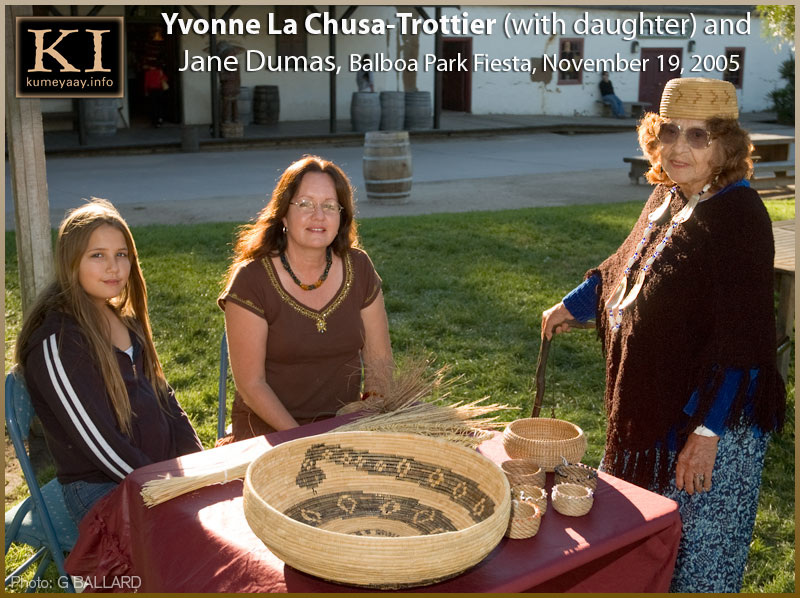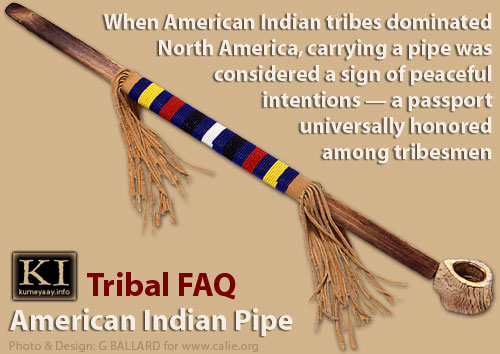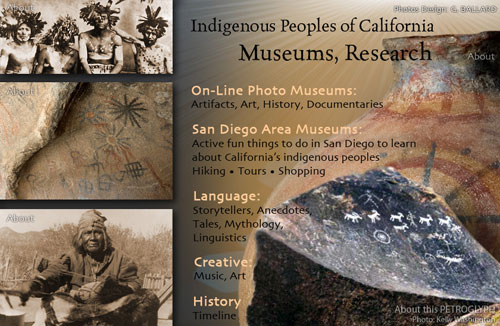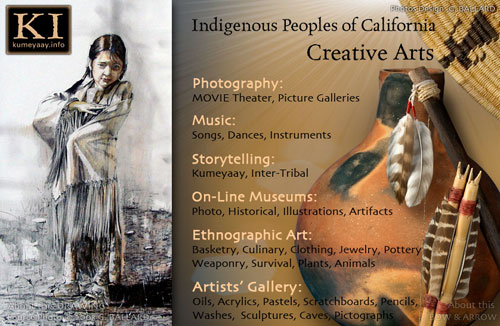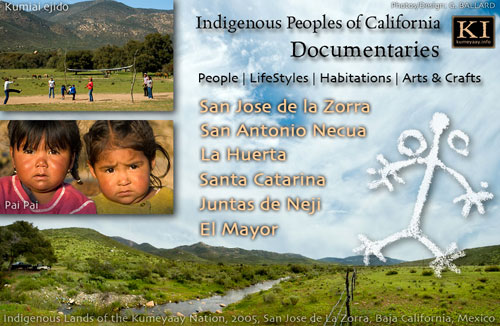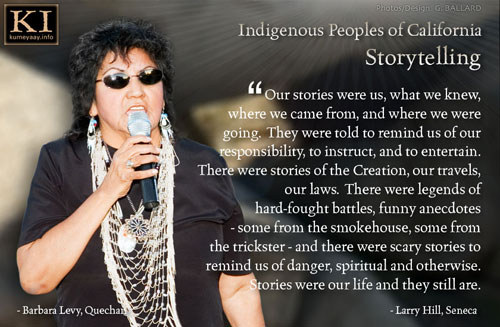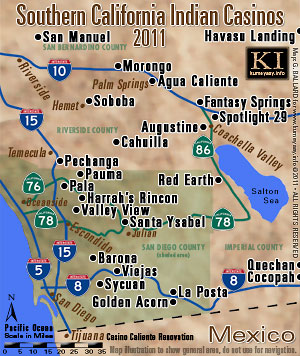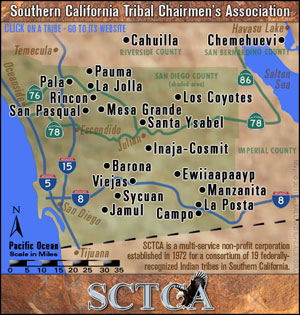 |
||
JANE DUMAS DAYEspañol | 中文 | 日本 | Française | Italiano | Deutsch | 한국어 | Россию | پارس Self-published by GARY G. BALLARD, photography, writing & design The City of San Diego proclaimed April 28, 2012, to be forever officially known as "Jane Dumas Day." Above photograph: Senior Park Ranger Sanford presents Jane Dumas (Kumeyaay elder, Jamul Indian Village) with her framed Proclamation during the Kumeyaay-Diegueño flag raising ceremony at Mission Trails Regional Park, Kumeyaay Lake and Campground, located in eastern San Diego near Santee, California.
Kumeyaay is Jane's first language and she remains one of the last living fluent speakers of the Kumeyaay language in the world. Jane's daughter, Daleane "Dee" Dumas-Adams passed away in March, 2009 — Daleane took an active role in founding this website.
|
||
Jane Dumas is an enrolled Kumeyaay tribal member of the Jamul Indian Village - A Kumeyaay Nation. The Jamul band is one of twelve sovereign, federally-recognized Kumeyaay bands indigenous to the Southern California region of the County of San Diego, Imperial County, and Baja California Norte, Mexico. Jane spent some of her early childhood in the Tecate countryside (US-Mexico border area). She currently resides in the City of Lemon Grove, just east of San Diego, and west of La Mesa, California. Jane teaches Southern California ethnobotany and Kumeyaay language at the Kumeyaay Community College (Sycuan Indian Reservation). School children may recall seeing Jane's published work, including the videos “Trails of the Kumeyaay” (1994), and “Stewardship Through the Ages” (1999). She has also given hundreds of public speeches about Kumeyaay history and culture throughout Southern California over the past 60 years. |
||
|
KUMEYAAY TRIBAL SINGERS Seven Kumeyaay bird singers honored Jane Dumas with traditional California Indian style singing — they are pictured singing and shaking gourd rattles during their Jane Dumas Day performance at the Kumeyaay Lake and Campground (4/28/2012):
KUMEYAAY-DIEGUENO TRIBAL FLAG CEREMONY The Mission Trails Regional Park held a special community event to honor Jane Dumas and the Kumeyaay tribe — including a raising of the official Kumeyaay-Diegueño Nation tribal flag. This was the first time the Kumeyaay tribal colors were raised at the Kumeyaay Lake and Campground, and it is significant because it is displayed alongside the American and California state flags in a public park. As noted below in the council's Proclamation, Jane Dumas played a key role in not only the creation of the Kumeyaay flag project, but also in establishing the official Kumeyaay presence at Mission Trails Regional Park over the past two decades. Jane blessed the Mission Trails Regional Park Visitor Center when it opened in 1995. Well done, Jane!
Kumeyaay photographs: Local Kumeyaay tribal members hoist their national flag at the public California park for the first time. Pictured (l-r): Louis Guassac (Mesa Grande), Anita Uqualia (Viejas), Jamie LaBrake (Sycuan), Leroy Elliot (Manzanita). Chairman Leroy Elliott congratulates Jane Dumas after completing his honoring song set. Mr. Elliott is a fluent Native speaker of his Kumeyaay language, a Kumeyaay bird song leader, and he is dedicated to the preservation and teaching of his Kumeyaay traditions and ageless Southern California American Indian tribal culture. The Kumeyaay flag, representing the 12 federally-recognized sovereign bands of the Kumeyaay tribe in the County of San Diego is displayed alongside the United States and California flags.
|
||
|
12,000 YEARS — 600 GENERATIONS IN SAN DIEGO BORDER REGION A true San Diego Native, Jane's Kumeyaay Indian ancestors have occupied the greater San Diego area for some 600 generations, 12,000 years (according to historical accounts and hard archeological evidence gleaned from many hundreds of local ancient indigenous sites that have been academically scrutinized and opined by scholars and scientists over the past 250 years or so).
Cultural activist in region steeped in San Diego tribal history:
Jane Dumas pictured above with master basket weaver Yvonne La Chusa-Trottier (Ipai, Mesa Grande) and her daughter in 2005 during the Annual Old Town San Diego Fiesta in Old Town San Diego. Yvonne displayed her Kumeyaay baskets during the cultural event. SHUMUP KO HUP (Dream Come True)
In about 2000, Jane and her daughter, Daleane, cofounded the Shumup Ko Hup gift shop in the San Diego Old Town State Park. Their Indian store sold only authentic traditional ethnographic art handcrafted by California Indians. In the store's heyday, Jane promoted and represented a thriving Southern California Indian co-opt of more than 60 Native California Indian artisans. Unfortunately for the community, Jane and Dee closed their popular gift shop and HOWKA.COM website in 2007 as a result of hard times during the Great Recession. KUMEYAAY TIME-LINE Brief 10000 B.C. — PRE-CONTACT: Museums full of Kumeyaay artifacts and scientific and academic studies citing archeological evidence suggest the Kumeyaay Indians have have occupied this region for at least 12,000 years — that's about 9,000 years before the Great Pyramid of Giza was built!!! 1542 — FIRST CONTACT: The first European explorer known to visit San Diego (1542) was a Spanish sailing expedition led by the Portuguese explorer Juan Rodriguez Cabrillo. Cabrillo sailed past what is now called Point Loma and landed in San Diego Bay — he promptly claimed the entire region for Spain under Doctrine of Discovery. 1769 — SPANISH MISSIONS & SETTLERS ARRIVE: When Spanish soldier/explorer Gaspar de Portolà and Father Junipero Serra founded the near-by Mission San Diego de Alcalá (1769), Old Town was known amongst the local population as Kosa'aay (a thriving and long-established Kumeyaay village). Some people speculate that Portolà's land exploration into California was indeed a quest to find the fabled Seven Cities of Gold, and the California Missions created bases from which to operate and gain the support and trust of the indigenous peoples. 1848 — US-MEXICO BORDER & CALIFORNIA GOLD RUSH: With the signing of the Treaty of Guadalupe Hidalgo that ended the Mexican American War (1846-1848), the American and Mexican governments cut their US-Mexico International Border through the heart of prime Kumeyaay ancestral homelands and separated the Kumeyaay tribe into two parts... in addition to the thirteen American Kumeyaay reservations in San Diego County, four Kumiai communities survive south of the international border at the turn of the 21st century. The California Gold Rush (1848-1855) is historically paramount to Kumeyaay history in San Diego — it was estimated that some 300,000 immigrants poured into California during this seven-year period effectively tripling California's population and decimating the indigenous tribal population as a result... it's been estimated that some $10 Billion (2002 dollars) in gold was taken from California tribal lands between 1848 and 1862.
|
||
|
Proclamation of the City Council Jane Dumas Day April 28, 2012 Presented by Councilmember Marti Emerald WHEREAS, Jane Dumas, of the Jamul Band of Kumeyaay Indians, is a well-known and highly revered elder, teacher, and leader both in the American Indian community and throughout San Diego County; AND WHEREAS, Jane’s mother, Isabel Thing, was a Kuseyaay, or medicine woman, who passed her vast knowledge of herbs, plants, and ancient remedies down to her daughter. For decades, Jane has dedicated herself to keeping alive her first language of Kumeyaay by sharing her impressive repertoire of Kumeyaay culture and medicine with other Kumeyaay, as well as with the general public, at special events and speaking engagements; AND WHEREAS, Jane helped found the San Diego American Indian Health Center in 1981, where she worked first as a home health aide and then as a traditional medicine specialist. Jane joined the Board of the Indian Human Resource Center in 1986; AND WHEREAS, in conjunction with the reopening of father Junipero Serra Trail Road in 1993, Jane took part in the naming and blessing ceremony for the Kumeyaay Lake and Campground (formerly known as Hollins Lake). Later that year, she participated in the groundbreaking and blessing ceremony for Mission Trails’ new Visitor and Interpretive Center and, in 1995, for the Center’s Grand Opening celebration; AND WHEREAS, Jane shared her knowledge of Kumeyaay culture in the filming of the “Trails of the Kumeyaay” video, produced in 1994, as well as in the “Stewardship Through the Ages” video, produced in 1999. Both of these excellent educational films are shown in the theater of the Mission Trails Visitor Center and are viewed by thousands of school children and people each year; AND WHEREAS, Jane Dumas was inducted into the San Diego County Women’s Hall of Fame in 2002 and is recognized as the catalyst for Mission Trails Regional Park acquiring a Kumeyaay-Diegueño Nation flag to fly proudly at the Kumeyaay Lake and Campground in her honor from here on out; AND WHEREAS, Jane continues to share her expertise in medicinal plants by teaching Ethnobotany classes at Sycuan’s Kumeyaay Community College. It is her hope that the knowledge and traditions of her people will continue to be passed down from generation to generation and never be forgotten; NOW THEREFORE BE IT PROCLAIMED, by the Council of the City of San Diego, that this Council, for and on behalf of the people of San Diego, does hereby declare April 28, 2012 to be “Jane Dumas Day” in the City of San Diego and commends Jane Dumas for her proud service to San Diego’s American Indian community and to our greater region. Signed by the Mayor and eight council members as approved April 24, 2012. City of San Diego seal attached, framed and presented to Jane April 28, 2012 during the Kumeyaay-Diegueño flag raising, Mission Trails Regional Park, Kumeyaay Lake and Campground. |
||
|
MORE ON-LINE KUMEYAAY RESOURCESitary veterans war heros community blogs....
|
||
| Professional photography, writing and design by San Diego photojournalist: GARY G. BALLARD | ||
| Terms of Use • Privacy Statement • Site Map Kumeyaay Indians Home • About Us • Mission Statement • Press Kit • Contact Us |


 Pictured left, just prior to beginning her invocation, Jane Thing-Dumas spoke to the crowd in both English and her native Kumeyaay language, San Diego's original language.
Pictured left, just prior to beginning her invocation, Jane Thing-Dumas spoke to the crowd in both English and her native Kumeyaay language, San Diego's original language.





